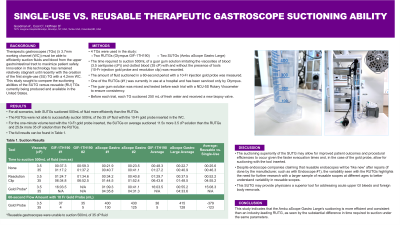Tuesday Poster Session
Category: GI Bleeding
P4186 - Single-Use vs Reusable Therapeutic Gastroscope Suctioning Ability
Tuesday, October 29, 2024
10:30 AM - 4:00 PM ET
Location: Exhibit Hall E

Has Audio

David Hoffman, MSPH, MBA
Ambu USA
Columbia, MD
Presenting Author(s)
Adam J. Goodman, MD1, Christina Cool, MPH2, David Hoffman, MSPH, MBA3
1NYU Grossman School of Medicine, Brooklyn, NY; 2Ambu USA, New York, NY; 3Ambu USA, Columbia, MD
Introduction: Therapeutic gastroscopes (TGs) (≥ 3.7mm working channel (WC)) must be able to efficiently suction fluids and blood from the upper gastrointestinal tract to maximize patient safety. Innovation in this technology has remained relatively stagnant until recently with the creation of the first single-use (SU) TG with a 4.2mm WC. This study sought to compare the suctioning abilities of the SUTG versus reusable (RU) TGs currently being produced and available in the United States.
Methods: Two RUTGs (Olympus GIF-1TH190) and two SUTGs (Ambu aScope Gastro Large) were used to measure the time required to suction 500ml of a guar gum solution imitating the viscosities of blood (3.5 centipoise (cP)) and clotted blood (35 cP) with and without the presence of tools (10-Fr injection gold probe and resolution clip). One of the RUTGs (#1) was currently in use at a hospital and has been serviced only by Olympus. The guar gum solution was mixed and tested before each trial with a NDJ-5S Rotary Viscometer to ensure consistency. For each trial, the endoscope distal tip was placed at the 100ml of the graduated cylinder. Before each trial, each TG suctioned 250 ml of fresh water and received a new biopsy valve.
Results: For all scenarios, both SUTGs suctioned 500ml of fluid more efficiently than the RUTGs. The full results can be found in Table 1. The RUTGs were not able to successfully suction 500ml of the 35 cP fluid with the 10-Fr gold probe inserted in the WC. A one-minute volume test was performed for all scopes with the 10-Fr gold probe at both 3.5 and 35 cP. In these scenarios, the SUTGs on average suctioned 11.5x more 3.5 cP solution than the RUTGs and 25.6x more 35 cP solution than the RUTGs.
Discussion: This study indicates that the Ambu aScope Gastro Large’s suctioning is more efficient and consistent than an industry leading RUTG, as seen by the substantial difference in time required to suction under the same parameters. This superiority may allow for increased patient outcomes and procedural efficiencies to occur given the faster evacuation times and in the case of the gold probe, allow for suctioning with the tool inserted. Although endoscope companies claim that reusable endoscopes will be “like new” after repairs (if done by the manufacturer, such as with Endoscope #1), the variability seen with the RUTGs highlights the need for further research with a larger sample of reusable scopes at different ages to better understand variability in reusable scopes.
Note: The table for this abstract can be viewed in the ePoster Gallery section of the ACG 2024 ePoster Site or in The American Journal of Gastroenterology's abstract supplement issue, both of which will be available starting October 27, 2024.
Disclosures:
Adam J. Goodman, MD1, Christina Cool, MPH2, David Hoffman, MSPH, MBA3. P4186 - Single-Use vs Reusable Therapeutic Gastroscope Suctioning Ability, ACG 2024 Annual Scientific Meeting Abstracts. Philadelphia, PA: American College of Gastroenterology.
1NYU Grossman School of Medicine, Brooklyn, NY; 2Ambu USA, New York, NY; 3Ambu USA, Columbia, MD
Introduction: Therapeutic gastroscopes (TGs) (≥ 3.7mm working channel (WC)) must be able to efficiently suction fluids and blood from the upper gastrointestinal tract to maximize patient safety. Innovation in this technology has remained relatively stagnant until recently with the creation of the first single-use (SU) TG with a 4.2mm WC. This study sought to compare the suctioning abilities of the SUTG versus reusable (RU) TGs currently being produced and available in the United States.
Methods: Two RUTGs (Olympus GIF-1TH190) and two SUTGs (Ambu aScope Gastro Large) were used to measure the time required to suction 500ml of a guar gum solution imitating the viscosities of blood (3.5 centipoise (cP)) and clotted blood (35 cP) with and without the presence of tools (10-Fr injection gold probe and resolution clip). One of the RUTGs (#1) was currently in use at a hospital and has been serviced only by Olympus. The guar gum solution was mixed and tested before each trial with a NDJ-5S Rotary Viscometer to ensure consistency. For each trial, the endoscope distal tip was placed at the 100ml of the graduated cylinder. Before each trial, each TG suctioned 250 ml of fresh water and received a new biopsy valve.
Results: For all scenarios, both SUTGs suctioned 500ml of fluid more efficiently than the RUTGs. The full results can be found in Table 1. The RUTGs were not able to successfully suction 500ml of the 35 cP fluid with the 10-Fr gold probe inserted in the WC. A one-minute volume test was performed for all scopes with the 10-Fr gold probe at both 3.5 and 35 cP. In these scenarios, the SUTGs on average suctioned 11.5x more 3.5 cP solution than the RUTGs and 25.6x more 35 cP solution than the RUTGs.
Discussion: This study indicates that the Ambu aScope Gastro Large’s suctioning is more efficient and consistent than an industry leading RUTG, as seen by the substantial difference in time required to suction under the same parameters. This superiority may allow for increased patient outcomes and procedural efficiencies to occur given the faster evacuation times and in the case of the gold probe, allow for suctioning with the tool inserted. Although endoscope companies claim that reusable endoscopes will be “like new” after repairs (if done by the manufacturer, such as with Endoscope #1), the variability seen with the RUTGs highlights the need for further research with a larger sample of reusable scopes at different ages to better understand variability in reusable scopes.
Note: The table for this abstract can be viewed in the ePoster Gallery section of the ACG 2024 ePoster Site or in The American Journal of Gastroenterology's abstract supplement issue, both of which will be available starting October 27, 2024.
Disclosures:
Adam Goodman: Ambu, Inc – Consultant. Boston Scientific – Consultant. Motus GI Holdings – Consultant.
Christina Cool: Ambu – Employee.
David Hoffman: Ambu USA – Employee.
Adam J. Goodman, MD1, Christina Cool, MPH2, David Hoffman, MSPH, MBA3. P4186 - Single-Use vs Reusable Therapeutic Gastroscope Suctioning Ability, ACG 2024 Annual Scientific Meeting Abstracts. Philadelphia, PA: American College of Gastroenterology.
